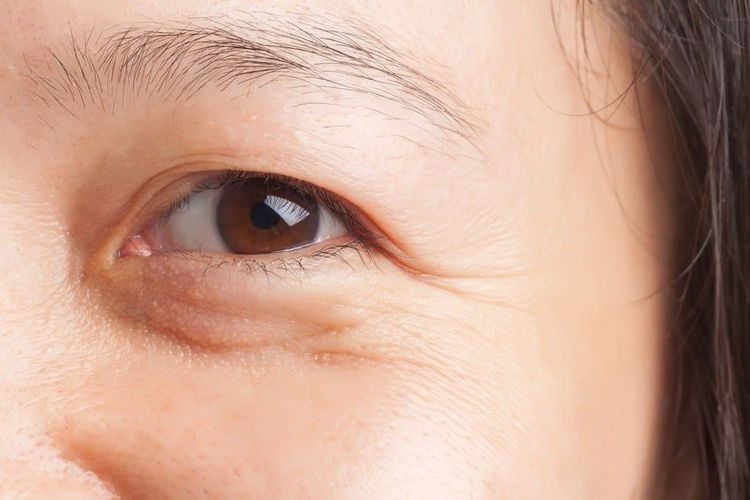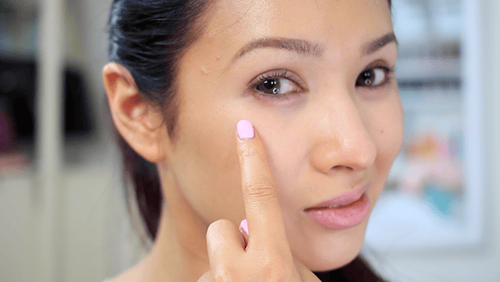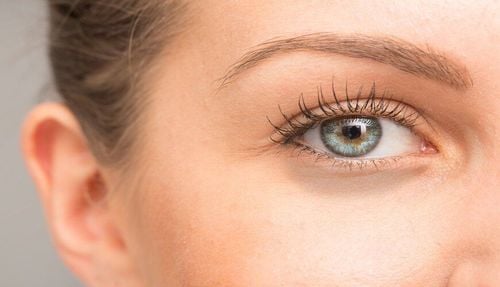This is an automatically translated article.
Puffy eyes are a sign of aging skin around the eyes, common in older people. However, puffiness can also form for many other reasons. Although they are sometimes benign, in some cases the appearance of puffiness is suggestive of a medical condition. Current aesthetic opinion holds that puffiness or eye bags can make you look drowsy and unhealthy. Thankfully, there are ways to reduce sagging and puffiness under the eyes.1. What is eye bags?
Eye bags also known as eye bags are common as you get older. As we age, the tissues around the eyes, including some of the muscles that support the eyelids, weaken. The normal fat that helps support the eye can then move into the lower eyelid, causing the lashes to appear puffy. Fluid also builds up in the space below your eyes, adding to the swelling.
Puffy eyes are often a common cosmetic concern and are rarely a sign of a serious underlying medical condition. Home remedies, such as cool compresses, can help improve the appearance of bags under the eyes. For persistent or bothersome eye bags, eyelid surgery may be a more suitable option.
2. Symptoms of eye bags
Puffy eyes can be easily recognized without medical care through the following signs:
Mild swelling Sagging or loose skin Dark circles If accompanied by other symptoms, lower puffiness can be is a sign of Graves' disease, also known as Basedow's disease, a thyroid disease that affects the eyes. Other Graves disease symptoms associated with the eyes include pain and redness, bulging eyes, irritation, and dryness. In the later stages, the disease can cause vision-related complications.
Ignoring adverse cosmetic effects, eye bags are usually harmless and do not require medical attention. However, people with puffy eyes should see a doctor if the swelling is more severe, persistent, painful, itchy, or red. Your doctor will examine you and order tests to rule out other causes that may be contributing to the swelling, such as thyroid disease, infection, or allergies. They may refer you to a doctor who specializes in eyes (ophthalmologist), plastic surgery, or ophthalmic surgery (eye surgeon).

Lão hóa da vùng mắt là một dấu hiệu phổ biến của tuổi già
3. What causes eye bags?
As you age, the tissue and muscle structures that support the eyelids also gradually weaken. Skin may begin to sag, and fat that is normally confined to the area around the eyes may move to focus on the area under your eyes. In addition, the space below the eyes has a loose tissue structure, which easily accumulates fluid, making the area under the eyes appear puffy, creating the image of puffiness.
Several factors cause or worsen these effects, including:
Fluid retention, especially after waking up or after a salty meal Genetics: Puffy eyes often have a familial tendency. If your loved ones are prone to bags under their eyes, you're also at a higher risk of developing the condition. In addition, an increase in the reticular vascular system under the eyes, sometimes genetic, can produce the illusion of darkness. Habits: Certain habits can increase the risk of puffiness under the eyes. Not sleeping well, smoking and eating a lot of salt all contribute to the formation of puffiness under the eyes. Allergies and thyroid conditions: Thyroid dysfunction, both hyperthyroidism and hypothyroidism, can cause puffiness or bags under the eyes. Treating thyroid conditions effectively will help improve the appearance of your eyes. Allergies that produce nasal congestion or sinusitis will also increase the size of puffiness. The blockage can cause blood to pool in the capillaries underneath the eyes, leading to puffiness and dark circles known as allergic shiners. To prevent eye swelling and puffiness from appearing, you can try to stay away from allergens as much as possible. Smoking: The toxins present in cigarette smoke have been shown to interfere with the formation of collagen and elastin. These are two substrates that are responsible for maintaining skin elasticity, firmness and plumpness. The habit of smoking has the ability to accelerate the aging process, making the skin under the eyes wrinkled and prone to puffiness.
4. How to treat eye bags?
Puffy eyes or eye bags are usually a cosmetic problem and do not require the application of specific treatments. Home and lifestyle treatments can help reduce or eliminate puffy eyes.
Available medical and surgical treatments should be consulted if you are overly concerned about the appearance of puffiness under the eyes. Treatment may not be covered by health insurance if it is done solely to improve your appearance.
4.1 Drug Treatments If you think your puffiness is caused by allergies, ask your doctor about prescription allergy medications.
4.2 Treatments Various wrinkle treatments are applied when caring for the skin around the eyes to improve the appearance of puffiness. These include laser resurfacing, chemical peels, and filler injections. These methods can improve skin tone, tighten skin, and rejuvenate the shape of eye bags.
Laser: This method involves using lasers in each area to remove layers of skin and encourage healthy new cell growth. This is a long-term treatment that helps tighten the skin. Radiofrequency: Instead of a laser, this treatment uses an electric current to tighten the skin. Intense Pulsed Light: This treatment eliminates hyperpigmentation for an even skin tone. Fillers: Inject fillers into the under-eye area to help smooth the skin under the eyes. Chemical peels: This method also removes layers, but through a chemical solution rather than a laser. It leads to brighter and tighter skin. 4.3 Eyelid surgery
Depending on the cause of the eye bags, eyelid surgery (blepharoplasty) may be a treatment option. During blepharoplasty, the surgeon removes excess fat through an incision in the natural crease of the upper eyelid or inside the lower eyelid. The doctor will then reattach the skin with small, sutured stitches. The procedure is usually done as an outpatient procedure, meaning that the patient does not need to stay in the hospital after surgery. In addition to correcting eye bags, a lacrimalectomy can also be performed in combination when:
Upper eyelids are wide or puffy The excess skin of the upper eyelids obstructs your vision Lower eyelids sag, which can cause visible white under the iris, colored part of the eye Excess skin on the lower eyelid Talk to your doctor about the side effects of eyelid surgery before deciding to have it, including: dry eyes, discharge tears, pain, swelling, bruising and blurred vision. Rare complications include decreased vision, bleeding, infection, eye muscle injury, corneal abrasion, and eyelid drooping.

Điều trị tình trạng bọng mắt, túi mắt có thể dùng tới thuốc hoặc nhiều biện pháp khác
5. Lifestyle and home remedies for puffiness
The following simple tips can help you reduce or eliminate eye bags:
Use a cool compress. Wet a clean towel with cool water. While sitting up, place a damp washcloth on the skin under and around the eyes for a few minutes by gently pressing. Cut back on fluids before bed and reduce salt in your diet. This will reduce water retention that can build up in the skin under the eyes, causing eye bags. Do not smoke. Smoking can worsen your eye bag problems. Get enough sleep . For most adults, seven to nine hours of sleep is a good amount of sleep. Elevate your head a little. Adding an extra pillow or head support can help. Or raise the entire headboard a few inches. This helps prevent fluid from building up around your eyes while you sleep. Dark circles caused by water retention in your lower eyelids usually go away when you wake up. Reduce allergy symptoms. Avoid allergens when possible. Try an over-the-counter allergy medication. Talk to your doctor about prevention strategies if you develop under-eye reactions from hair dyes, soaps, cosmetics, or other allergens. Use cosmetics. If you want to cover up your dark circles and puffiness, try makeup. In case you have applied the above methods, but the condition of the lower eye bags does not tend to decrease or they simply make you self-conscious about your appearance, you can contact Vinmec International General Hospital for a doctor's appointment. The doctor examines and advises on surgical methods for facial puffiness.
Please dial HOTLINE for more information or register for an appointment HERE. Download MyVinmec app to make appointments faster and to manage your bookings easily.
Reference source: mayoclinic.org - verywellhealth.com







